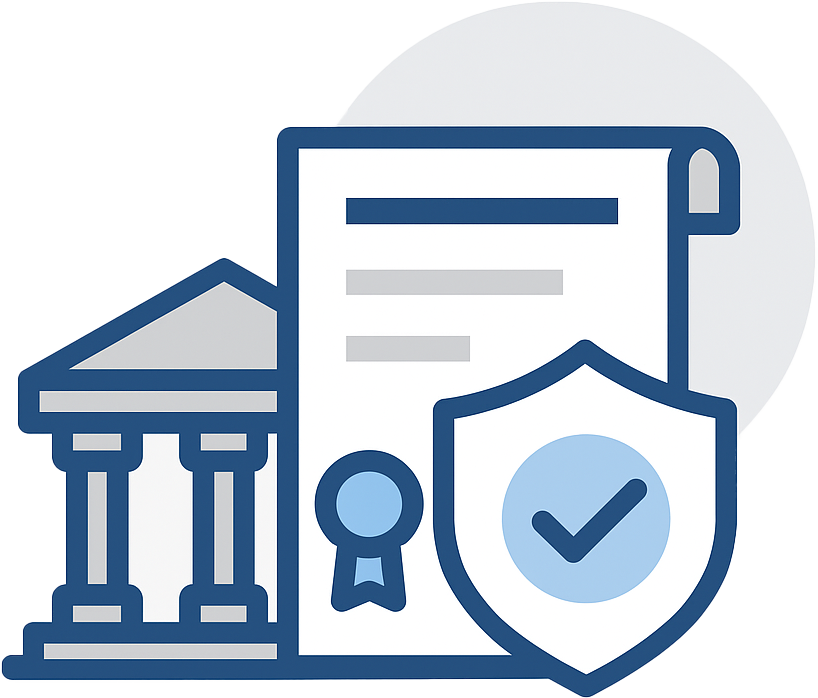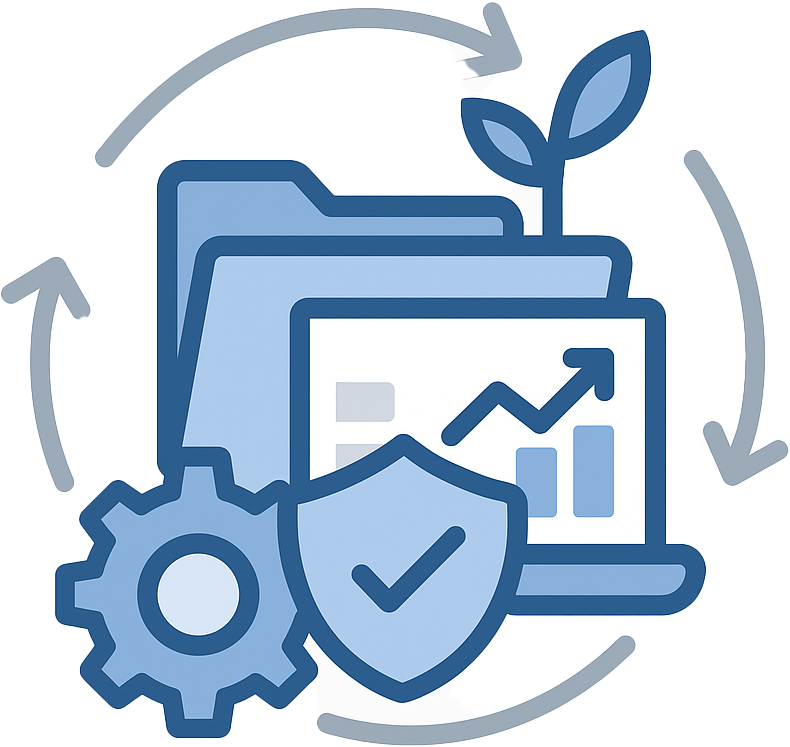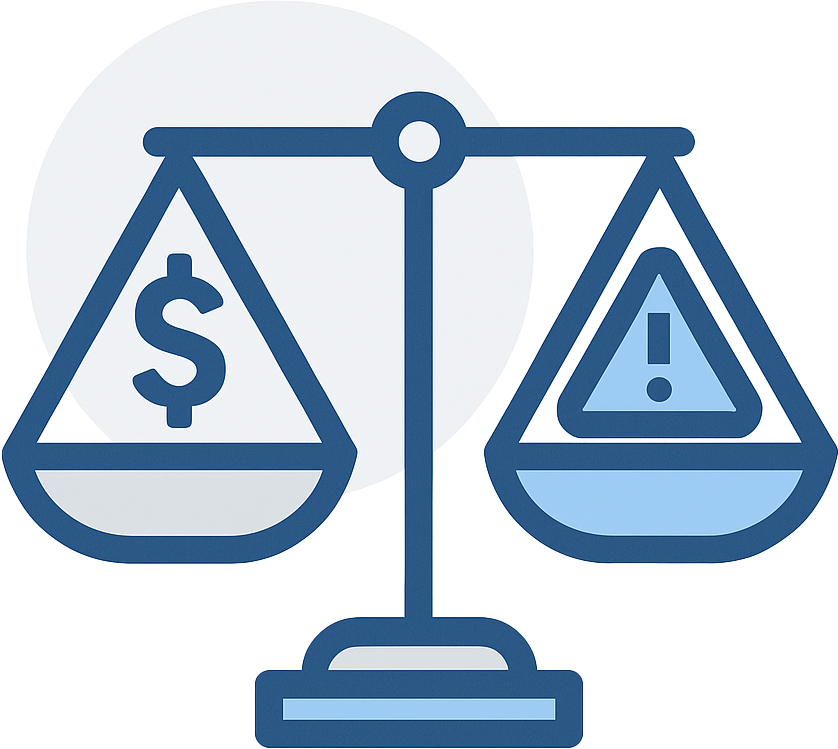Becoming An EMS Expert
Ever feel like you’re just crossing your fingers when it comes to environmental compliance? If you're the one responsible for SPCC plans, NPDES permits, inspections, training, or just making sure your facility doesn’t get fined, you’re not alone - and the pressure is real.
The problem is, too many businesses are managing their environmental obligations without a clear system. That means tasks fall through the cracks, compliance gets reactive instead of proactive, and when something goes wrong, there’s no documented proof that you were doing things right.
In this guide, we’ll break down exactly what an Environmental Management System (EMS) is, what it includes, how much it costs, and whether it makes sense for your business - in plain English, with no fluff. And if you still have questions or just want to pick someone's brain, reach out here to talk about an EMS for your business!
Table of Contents
What is an Environmental Management System (EMS)?
An Environmental Management System (EMS) is a structured way to manage your environmental responsibilities, so nothing slips through the cracks, and you can prove you’re doing things right.
It’s the backbone of a strong environmental program. Instead of juggling permits, inspections, training, and reporting in separate silos (or worse, scattered spreadsheets), an EMS brings it all together into one organized, repeatable system.
A well-built EMS answers questions like:
- Who’s responsible for each task?
- What are the procedures and timelines?
- Where are the records kept?
- How do we make sure it actually gets done?
It doesn’t have to be complicated, and it definitely shouldn’t just sit on a shelf. Whether you’re aiming for ISO 14001 certification or just want a smarter way to manage compliance, a good EMS is designed to work with your operation, not against it.
So… what actually is an EMS? A book? A software platform? A plan?
Yes, it can be all of those! But more importantly, an EMS is a system, not a specific format. It might be a digital platform, a set of spreadsheets and procedures, or a physical binder with your policy, plans, and records. It could live in your SharePoint, in a compliance software tool, or even in a well-organized filing cabinet. The format doesn’t matter nearly as much as the function.
At its core, an EMS is whatever setup allows you to consistently manage your environmental responsibilities. That means tracking tasks, training staff, keeping records, staying ahead of due dates, and improving over time. Some companies use software. Others use structured checklists and calendars. Some clients we work with already have pieces of an EMS, they just need help pulling it all together into something they can trust. We help you find the format that works for your operation, your people, and your risk level - and we build it so it lasts.
For more of the basics, check out: What is an Environmental Management System?

How to Know If You Need an EMS
If you’re responsible for environmental compliance and you’re tired of playing defense, there’s a good chance you need an EMS. It’s not just for giant corporations or companies going for ISO certification. In fact, the smaller or leaner your team is, the more valuable a clear system becomes.
You might benefit from an EMS if:
-
You manage multiple environmental programs (SPCC, NPDES, TRI, etc.). Each one has its own rules, deadlines, and documentation, and without a system, it’s easy for things to fall through the cracks.
-
You have more than one facility or operate in multiple states. Different locations often have different regulatory requirements, and an EMS helps standardize your approach across all of them.
-
You’ve had issues in the past: missed reports, gaps in documentation, close calls, or actual fines. An EMS helps prevent those problems from repeating and gives you proof that you’re taking compliance seriously.
-
You’re hiring new people and need to hand off responsibility with confidence. When roles change, your system stays the same, which means nothing gets lost in the shuffle.
-
You’re tired of reinventing the wheel every time something is due. An EMS puts recurring tasks like inspections, submissions, and training on autopilot with checklists, timelines, and accountability.
-
You’re bidding on government or corporate contracts that ask about your EMS or sustainability program. Having a documented EMS in place can be the difference between winning and losing a job.
You don’t need to wait for a violation or audit to justify it. Most companies we work with say the same thing: “We just want to get ahead of it, and not worry about this anymore.” That’s exactly what a good EMS is built to do.
For a deeper dive, read: The Top 7 Reasons You Need an EMS!

The Core Components Every EMS Should Include
While every EMS looks a little different depending on the company, most solid systems include the same core building blocks. Whether you're aiming for ISO 14001 alignment or just need a smarter way to manage your environmental programs, here’s what’s typically included:
-
An environmental policy. This is your high-level statement - your “why” - that outlines your environmental goals and commitment. It’s often required for permitting, audits, or corporate ESG efforts.
-
Defined roles and responsibilities. Who’s responsible for inspections? For reporting? For keeping training up to date? A good EMS makes it crystal clear... no more “I thought someone else was handling that.”
-
Standard operating procedures (SOPs). These are your step-by-step instructions for doing things the right way, from handling hazardous waste to preparing for site visits. Clear SOPs reduce mistakes and help with training and handoffs.
-
Training programs. Your EMS outlines what training is required, who needs it, how often, and where the records live. Whether it’s SPCC training or stormwater awareness, this keeps you compliant and covered.
-
Document control and recordkeeping. You’ll need a way to store, organize, and retrieve documents (like permits, reports, inspections, and corrective actions), so you’re always ready for an audit or internal review.
-
Monitoring and measurement. An EMS helps you track compliance metrics, inspection results, and environmental performance indicators. You can’t improve what you don’t measure.
-
Corrective and preventive actions. Things go wrong... but how you respond matters. Your EMS gives you a framework for fixing issues, documenting what happened, and preventing future problems.
-
Management review and continuous improvement. This is what makes an EMS a system, not just a filing cabinet! Regular reviews help you spot trends, set goals, and make sure your program is actually working.
Not every company needs every single piece, but these are the pillars of an EMS that works. At RMA, we help you figure out which elements matter most for your operation and build a system that fits, not one that overwhelms.

What Do EMS SOPs Actually Include?
One of the most common questions we get is: “What kind of procedures should actually go into an Environmental Management System?”
While every EMS is tailored to the specific needs of the facility or organization, most well-built systems include a set of SOPs (Standard Operating Procedures) that cover both compliance requirements and internal best practices. These SOPs serve as your team's playbook, outlining how things should be done, who’s responsible, and how to document each step.
Here’s a sample SOP table of contents we might build for a client. Not every company needs all of these, but this gives you a clear picture of what’s possible:
-
Environmental Policy Statement – Your organization’s overarching commitment to environmental responsibility, compliance, and continuous improvement.
-
Roles & Responsibilities Matrix – A clear list of who is responsible for what (inspections, reporting, training, reviews) so nothing gets missed or duplicated.
-
Training Requirements & Schedule – Defines which roles need environmental training (e.g., SPCC, stormwater, hazardous waste) and how often it must be refreshed.
-
Regulatory Compliance Calendar – A month-by-month calendar of key environmental deadlines, submission dates, inspection periods, and recurring tasks.
-
Stormwater Inspection Procedure – Step-by-step instructions for how to inspect stormwater infrastructure, document findings, and respond to issues.
-
SPCC Inspection & Response Procedure – Lays out how to perform oil and tank inspections under your SPCC plan, including spill response actions.
-
Hazardous Waste Handling SOP – Guidance on proper storage, labeling, and disposal of hazardous wastes according to federal and state regulations.
-
Universal Waste Management SOP – Defines how to handle items like batteries, lamps, and electronics under universal waste rules.
-
Incident Reporting & Investigation SOP – Instructions for how to report, document, and investigate spills, releases, or near-misses.
-
Corrective and Preventive Action Process (CAPA) – Defines how issues are documented, assigned, and resolved to prevent repeat problems.
-
Document Control Procedure – Outlines how EMS documents are created, revised, approved, and archived, key for audits and consistency.
-
Internal Audit Procedure – Provides a checklist and process for conducting internal EMS reviews to catch issues before regulators do.
-
Management Review Process – Describes how leadership reviews EMS performance, sets goals, and makes improvement decisions.
-
Annual EMS Review Checklist – A once-a-year review process to confirm the EMS is still accurate, complete, and actively being used.
These SOPs form the operational backbone of your EMS. They help new hires ramp up faster, reduce the chance of human error, and show regulators that you’re serious about compliance. At RMA, we build custom SOP packages based on your exact operations, existing programs, and regulatory obligations, so you only get what you actually need (and nothing you don’t).

The 5 Key Steps to Building Your EMS From Scratch
Building an EMS doesn’t have to be overwhelming, especially when you have a clear roadmap and the right partner. Whether you’re starting from scratch or trying to bring some structure to a scattered system, the process usually follows these five steps:
-
Initial Assessment - We start by learning how you currently manage your environmental responsibilities - what’s working, what’s missing, and where your biggest risks are. This gives us a baseline and helps us tailor your EMS to your operation, not someone else’s.
-
Gap Analysis - We compare your current state to industry best practices or ISO 14001 standards (if that’s your goal). We identify exactly what you have, what you need, and what it’ll take to get there.
-
Program Design - We build the EMS framework, including your environmental policy, roles and responsibilities, procedures, training plan, and recordkeeping system. We also recommend tools and templates to make it easier to manage moving forward.
-
Implementation and Rollout - We help you roll out the system, train your team, and make sure everything’s in place. This step is all about getting buy-in, setting expectations, and making sure people actually use the system.
-
Ongoing Support (Optional) - Once your EMS is in place, we can stick around to help manage it, including audits, updates, inspections, and compliance questions. Some clients keep it all in-house. Others ask us to be their outsourced environmental team. We’re flexible.
Some EMS programs take 3–4 weeks to put together. Others evolve over months as part of a broader compliance or sustainability strategy.
It’s Not Done When It’s Built: The EMS Cycle
It’s important to understand that building an EMS isn’t the finish line - it’s the starting point. A functional Environmental Management System follows a cycle called Plan-Do-Check-Act (PDCA), which is the foundation for making sure your system actually works over time.
-
First, you plan: laying out your policies, responsibilities, procedures, and goals.
-
Then you do: putting those plans into action through training, inspections, reporting, and daily tasks.
-
After that, you check your performance. Are deadlines being met? Are procedures being followed? Are there any gaps?
-
And finally, you act: making improvements, updating the system, and ensuring it evolves with your operation.
EMS cycles can be defined, and they should be. Most companies run on either a quarterly or annual cycle, depending on the complexity of their operations and how quickly things change. In lower-risk environments, it might make sense to review and adjust the EMS once per year. In more dynamic settings, it’s often better to move through the cycle every few months to catch issues early and keep everything on track.
You can build the initial framework of an EMS in just a few weeks. But it’s going through that cycle (consistently) that makes it meaningful. That’s where most companies struggle, and it’s also where we often step in. Whether you just need a plan or want long-term support, we can help make sure your EMS isn’t just a binder on a shelf, it’s a tool you actually use.

How Much Does an EMS Cost?
The cost of building an Environmental Management System depends on a few key factors, like the size of your operation, the number of environmental programs involved, and whether you’re aiming for basic compliance or ISO 14001 alignment.
For most clients, the upfront cost to develop and implement an EMS falls somewhere between $5,000 and $25,000. That range covers everything from a basic, facility-specific EMS for a single site to a fully customized, multi-location system with ongoing support.
The biggest cost drivers are:
- Number of facilities or operational sites
- Regulatory complexity (SPCC, NPDES, TRI, waste, etc.)
- Desired level of depth (basic plan vs. ISO-aligned system)
- Internal involvement (whether you want us to build it all for you or guide your team through it)
Some clients also choose to keep us on for ongoing support, like updating SOPs, performing internal audits, preparing for site visits, or maintaining records. That’s typically billed monthly or quarterly and scaled to your needs.
Real EMS Price Estimates Based on Project Type
Building an Environmental Management System is an upfront investment - but one that pays off in clarity, compliance, and long-term peace of mind. Most of the cost is frontloaded during the setup phase. That’s when we build or organize your policies, procedures, training structure, and compliance calendar. Once your EMS is in place, ongoing costs are optional and usually much lower, depending on how much support you want from us moving forward.
Here’s what a typical EMS project looks like, based on the scope and complexity:
|
Type of EMS
|
Typical Cost Range
|
Timeline
|
Example Use Case
|
|
Basic EMS
|
$5,000–$9,000
|
6–8 weeks
|
A single-location facility like a concrete plant or small industrial site. Needs clear SOPs, training tools, and compliance calendar to stay ahead of regulators. No ISO certification required.
|
|
Multi-site EMS
|
$10,000–$15,000
|
8–12 weeks
|
A company with 3–5 locations in different states. Needs standardized documentation, consistent inspections, and a unified EMS approach across all sites.
|
|
ISO-Aligned EMS
|
$15,000–$25,000+
|
10–16 weeks
|
A larger operation or enterprise aiming for ISO 14001 certification. Requires deep documentation, internal audit systems, corrective action tracking, and long-term performance metrics.
|
In all cases, the majority of the cost is paid during setup. After that, clients have options:
- Run the EMS internally using the tools and training we’ve provided
- Engage us for ongoing support - monthly, quarterly, or just during key compliance deadlines
For more reading on this, check out: What is the cost or price of an Environmental Management System?

Who Can Put Together an EMS for Me?
In theory, anyone with enough time, knowledge, and attention to detail can build an EMS... but in practice, most companies either don’t have the bandwidth or aren’t sure where to start. That’s why many turn to outside help.
Some companies assign the task internally to an EHS manager, safety officer, or environmental lead. If that person has experience with SPCC, NPDES, training programs, audits, and documentation, it can be done in-house. But in most cases, EMS development ends up on the back burner (and stays there) because the day-to-day fires take priority.
That’s where we come in. At RMA, we design EMS programs that actually work for your team. We don’t believe in overbuilding. We focus on right-sized systems that reflect your risks, responsibilities, and resources. Sometimes that means building everything from scratch. Other times, we help organize and optimize what you already have so you’re not starting over, just leveling up.
Whether you want a full turnkey solution or just need guidance to get started, we’ll help you figure out the right approach.
Common EMS Misconceptions
A lot of companies either put off building an EMS or underestimate the value of having one, usually because of one of these common (but false) assumptions:
“We’re too small to need something like that.”
Actually, the smaller your team is, the more important it is to have a clear system. When everyone’s wearing multiple hats, a documented EMS makes sure nothing gets missed and anyone can step in if needed.
“We already do safety. Isn’t that enough?”
Safety and environmental compliance are not the same, and regulators treat them differently. You may have great safety procedures in place, but if you’re not managing your environmental responsibilities separately, you’re still exposed.

“We’ve never had an issue, so we’re probably fine.”
No news isn’t always good news. Many compliance issues go unnoticed until someone files a complaint, a spill happens, or an inspector shows up. An EMS helps you stay ahead of problems before they become violations.
“This is just paperwork - it doesn’t actually help us.”
Done right, an EMS isn’t just documentation, it’s a system for reducing risk, avoiding fines, improving accountability, and saving time. The goal is to make your job easier, not harder.
“We’ll do it when we have more time.”
That time rarely shows up on its own. In the meantime, the risks (and the pressure) keep building. Most companies are surprised how quickly an EMS can come together with the right help, and wish they’d started sooner.
“Don't we need ISO certification to have an EMS?”
Not at all. Many companies use EMS frameworks for internal control only. We build both internal-use and ISO-aligned systems, depending on your goals.
“We're already out of compliance, we can't do it until we fix things.”
That’s actually the best time to build an EMS. We can help you fix issues and put a system in place to prevent them from happening again.
And if you still need convincing, read: What are the benefits of an EMS?

What Makes RMA's EMS Programs Different?
We don’t just hand you a generic binder and walk away. And we’re definitely not here to lock you into another subscription you don’t need.
At RMA, we build Environmental Management Systems that actually fit the way your business runs, not just how the regulations are written. Whether you need an EMS for internal use only or you’re looking to move toward ISO 14001 certification, we’ll help you design the right structure, at the right depth, for your operation.
We don’t sell EMS software, and frankly, we’re not fans of most of what we see on the market. A lot of platforms are one-size-fits-all, bloated with features you’ll never use, and expensive to maintain. That’s not what we do. We’re not pushing a product. We’re helping you build a system that actually works for your team - whether that means a SharePoint system, a set of linked spreadsheets, a policy and training framework, or something in between.
Here’s what sets us apart:
-
We right-size the system. Whether you need something light and simple or a full ISO-aligned framework, we build what makes sense for your goals, not what looks good in theory.
-
We make it understandable. We don’t bury you in jargon or hand over a 100-page PDF no one will read. Everything is built to be used, not just stored.
-
We offer flexible support. You can build it with us and manage it yourself, or we can help maintain it with updates, audits, or monthly check-ins. Your call.
-
We show our work. Every EMS comes with walkthroughs, tools, and documentation so you can feel confident using it and explaining it to anyone who asks.
-
We’re not trying to upsell you. No software subscription. No ongoing fees unless you want support. Just a system that works.
If you’re looking for an EMS that actually helps you sleep better at night (without the fluff) we’d love to help. So, is an EMS right for you? If you’ve made it this far, you probably already know the answer.
Whether you’re juggling compliance requirements across multiple programs, struggling to keep things organized, trying to train new staff, or just tired of hoping you don’t get audited, an Environmental Management System is one of the smartest moves you can make.
It doesn’t have to be complicated. It just has to work. And it has to work for you. If you're interested in learning more about whether an EMS would benefit you, let's talk about what an EMS could look like for your business.


















